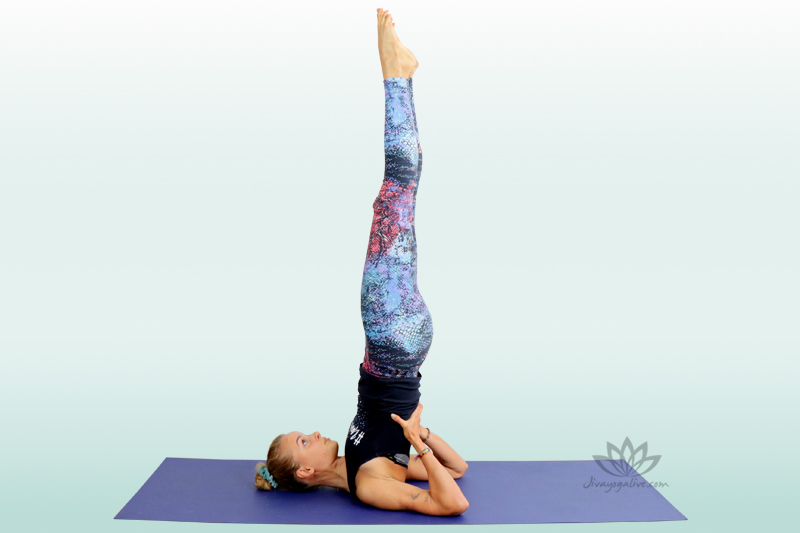This article will introduce you to seven different asanas to improve your flexibility and strength, we will be moving through a short but challenging flow using ocean breath helping us to keep warm and to get deeper into our practice. You will be feeling calm but very energized with gained clarity after completing the flow.

TRAINING TYPE: FLOW SEQUENCE
CATEGORY:YOGA
SUBCATEGORY:FLEXIBILITY & STRENGTH
PLANNED TIME:15 MINUTES
LEVEL:ALL LEVELS
PROPS:NONE
7 Yogic Exercises For Strength & Flexibility
Join me in this short challenging flow to improve your flexibility and strength! Pause your day by treating your body with this 15min practice, leaving you feeling empowered and calm with gained clarity.
Yoga Exercises For Strength & Flexibility Infographic

Mountain Pose - Tadasana
Coming into a mountain pose, grounding your feet on the ground, rolling shoulder back and engaging legs. Starting your practice with Ujjayi breath. Start by inhaling deep, pulling our pelvic floor up, engaging your abs and exhaling as if you would like to fog the glass. Instead of exhaling through the mouth, exhale through the nose.
This is also known as the ocean breath and it is commonly used in practice because it heats the body and keeps you warm throughout the flow.

Extended Side Angle Pose - Utthita Parsvakonasana
Inhale, step or jump your feet about 4ft apart, extending arms on the sides, turning the left heel in, right foot parallel to the front edge of the mat. Exhale, bend your right knee over the right ankle, extend right arm out as far as possible before placing it on the floor, outside of the right foot. Now here are a few variations, you can either place your palm completely on the floor, come onto your fingertips, use a block or place your elbow on your knee. Listen to your body and do as it feels today.
Keep your pelvis tucked in, open chest up towards the ceiling, press your right knee into right arm and push the floor with you back foot. If you can not keep your left heel on the ground, you can move yourself close to a wall and place the left foot so that you can press against the wall with it.
Gaze the left hand. If you have any neck problems, don’t try to follow your arm with your gaze, instead, look straight in front of you. Stay here for five long breaths, inhale come up, exhale repeat to the other side. This asana strengthens and stretches the knees, legs and ankles.

Revolved Side Angle Pose - Parivrtta Parsvakonasana
Exhale, shift the weight so that your right knee is directly bent over your right ankle. Bring your left elbow outside of your right knee and place your hands in Anjali Mudra. Inhale, open chest towards the ceiling with the help of your arms, press mudra on the knee and adjust your arms so that your hands are in front of your heart center, shoulders wide open. If you want to deepen this posture, place your left arm inside of your right foot, and send your right arm over above your head, following it with your gaze. Again, if your neck is not okay, just keep your gaze directly in front of you. Hold for five breaths, inhale come up, exhale do the other side.
This asana improves balance, digestion and stamina.

Intense Side Stretch Pose - Parshvottanasana
Inhale, come into tadasana, place your hands in namaste behind your back, or if this is not possible, hold opposite elbows behind the back. Inhale, step your right foot back, exhale, turn the left foot in, turn the hips to the right and make sure your legs are active so that you are protecting your knees. Inhale, look up and open chest, exhale press palms together, stretch to the front and then bend down from the hips, bring your chin towards your shin.
Make sure your back stays straight. Pull your right hip back so that your hips are square, and lift elbows. Stay for five breaths. Inhale, come up, exhale, turn your hips to the left, shift feet. Inhale open chest, look up, exhale, bend forward. Stay for five breaths.

Eagle Pose - Garudasana
Inhale, returning to Mountain Pose, exhale, bend your knees. Activate your left leg pulling your kneecap up, and inhale, raise your right leg, and cross you right thigh over your left. You can also help your right leg by lifting it with your hands. If you are able to, exhale and bring your right foot into a hook behind you left calf. If this feels impossible and your balance is not quite there yet (don’t worry, it’ll get there after a little practice!), you can also place the right foot on top of a block. Inhale lift arms and cross your left elbow above the right one and bring either your palms or the back of your hand together.
If you cannot bring your palms to touch but want a little bit of a deeper stretch, you can hold your left thumb with the fingers of your right hand. Inhale, lift your elbows, and exhale, draw your shoulder blades back. Now from here if you feel good, sit down a little lower, keeping your back still straight. If you have a drishti, a steady point of focus, it will make it a whole lot easier to balance. Stay for 3-8 breaths. Inhale come up, exhale release, inhale repeat to the other side.
This is a great pose because the compression that it builds in the body, it then brings fresh blood everywhere, creating an energizing and detoxifying effect in your body. It also is great for improving your balance, strengthening your lower body, opening your hips and it even helps with pain in the upper back.

Wide-Legged Forward Bend - Prasarita padottanasana
Returning to Mountain Pose, inhale, raise your arms straight to the sides, walk your your ankles underneath your wrists, feet parallel with the outer edges of the mat, hands on hip joints. Engage and activate your legs by pulling your kneecaps up, inhale deep and look up, lifting chest and the heart up to the sky, tucking pelvis in. Exhale bend forward from your waist, drawing your shoulder blades together whilst you keep on lowering yourself down. Never lock your knees but keep them microbended, not to damage your joints.
If you feel pain in your lower back, bend knees even more or come out of the asana. After lowering yourself halfway with a straight back, place both hands on the floor, pressing palms on the mat. between your feet about a shoulder width apart. Relax neck. Lengthen your spine more by bending your elbows, the goal is to bring the crown of your head to the mat. If your head is very far from the mat, try walking your legs out a bit wider, carefully. Remember to keep your fingers wide, pressing to the mat with your palms and feet. Stay in for 10 breaths. To release this pose place hands on your hips, and with an inhale lift your elbows towards the ceiling, draw your belly in and come up with a straight neck and back.
Benefits of this asana are that it creates a better posture, improves digestion, helps with lower backache, stretches the lower body and it calms stress and anxiety.

Supported Shoulderstand Pose - Salamba Sarvangasana
From Wide-legged forward bend we move into our last pose which is a Supported Shoulderstand Pose. Now this is considered to be the queen of the poses. It soothes the nervous system, increases strength and flexibility, relieves the flu, helps with sleep and strengthens the immune system.
Coming into a seated position, taking a grip from behind your thighs, lowering yourself gently to the floor. Walk your heels close to your sitting bones, place your arms beside your body and reach your heels with your fingertips. Start rolling your shoulders gently underneath you, lifting the heart center up a little. Make sure heels, knees, and hips are on the same line. Before we go into the asana, remember to never move your head from side to side when in a shoulderstand. And now with an inhale, lifting your legs up, exhale, lift legs over head, toes touching the floor, placing hands on the back, as close to your shoulders as it is possible for you today. Make sure your elbows are not wide open, walk them in towards each other and take chin away from the chest. Inhale, raise your legs up, over your head supporting your back with your arms. If possible walk hands even closer to shoulder, but remembering to keep your elbows still close to each other. Hold the Supported Shoulderstand for 5-15 breaths. When coming out, exhale, bend knees and let yourself slowly to the ground.
Stay lying on your back for a few breaths, relaxing, closing your eyes and seeing how this practice affects your body. Give yourself thanks for challenging your mind and body today.

Featured Video: 7 Challenge Yoga Poses For Flexibility and Strength
About
Sara
I then realized how big of a shift my life had taken to a better direction since starting yoga. I felt passionate about sharing it with others and Read More..




